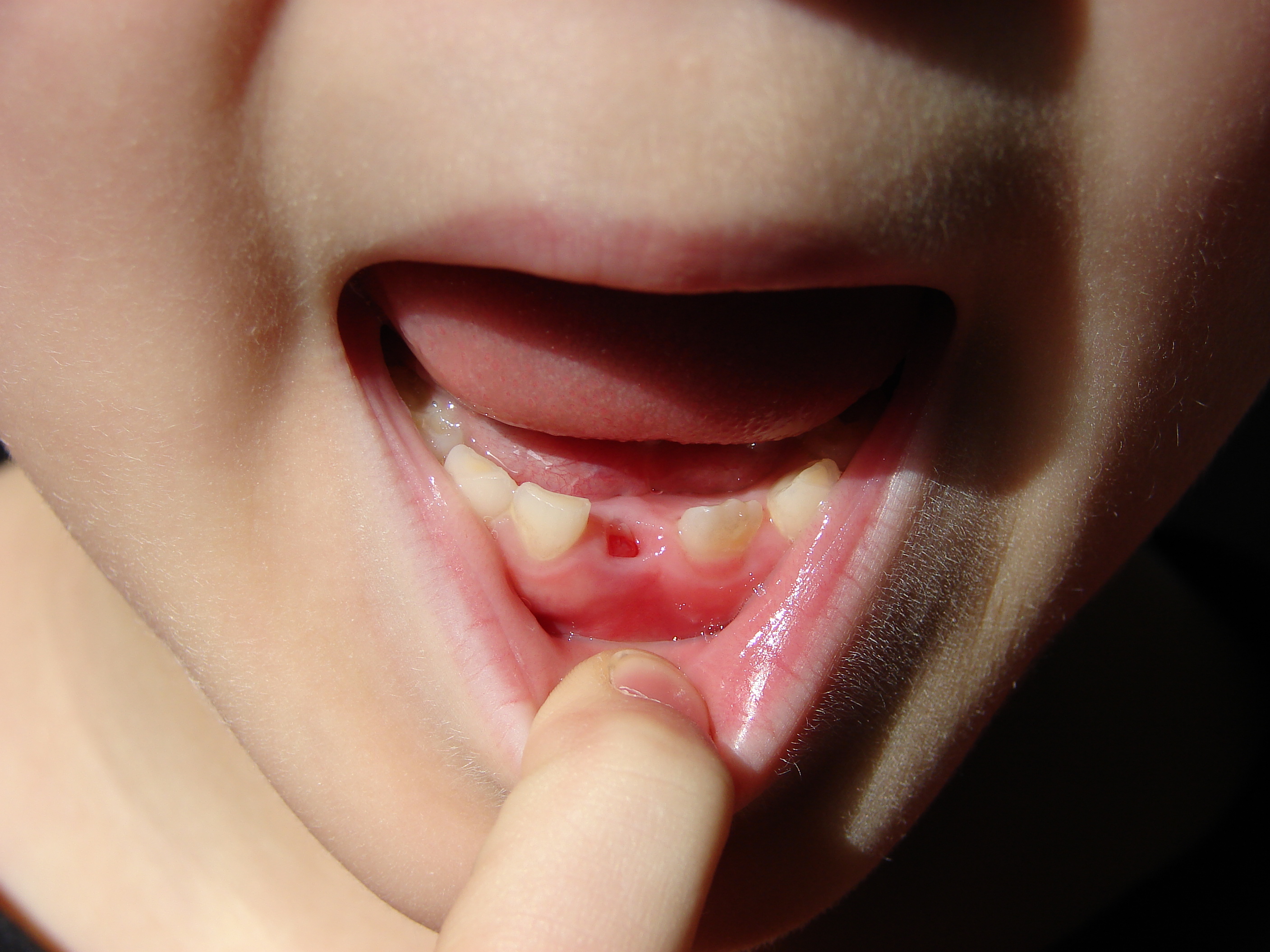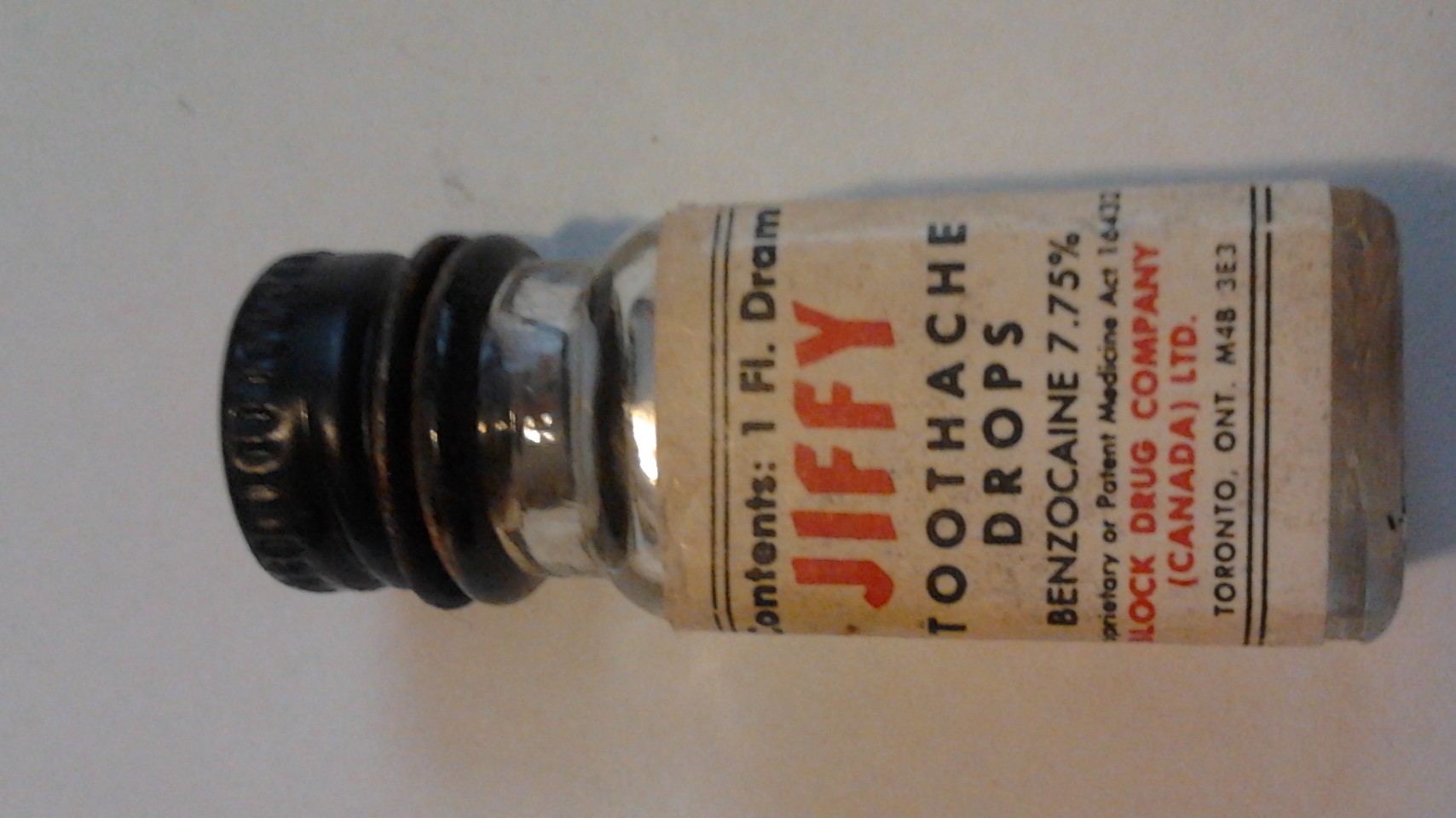|
Teething
Teething is the process by which an infant's first teeth (the deciduous teeth, often called "baby teeth" or "milk teeth") appear by emerging through the gums, typically arriving in pairs. The mandibular central incisors are the first primary teeth to erupt, usually between 6 and 10 months of age and usually causes discomfort and pain to the infant. It can take several years for all 20 teeth to complete the tooth eruption. Though the process of teething is sometimes referred to as "cutting teeth", when teeth emerge through the gums they do not cut through the flesh. Instead, hormones are released within the body that cause some cells in the gums to die and separate, allowing the teeth to come through. Teething may cause a slightly elevated temperature, but not rising into the fever range of greater than . Higher temperatures during teething are due to some form of infection, such as a herpes virus, initial infection of which is extremely widespread among children of teething a ... [...More Info...] [...Related Items...] OR: [Wikipedia] [Google] [Baidu] |
Teether
A teether, teething toy, or chew toy is a device given to teething infants. Most modern teethers are silicone, but can also be made of wood or rubber. Some teethers are filled with a fluid or gel that can be frozen or refrigerated. They differ from pacifiers in that they are intended to be chewed, rather than sucked on. They come in a variety of different shapes. Teethers may help relieve teething pain and help new teeth penetrate the gum, as well as provide a form of entertainment. Teething necklaces and teething bracelets may pose a choking hazard to infants and toddlers depending on the teething parts, and have prompted recalls. Teethers filled with liquid have also been recalled because of bacterial contamination. Early teethers were often teething rings. Teething biscuits, like rusk A rusk is a hard, dry biscuit or a twice-baked bread. It is sometimes used as a teether for babies. In some cultures, rusk is made of cake, rather than bread: this is sometimes referred t ... [...More Info...] [...Related Items...] OR: [Wikipedia] [Google] [Baidu] |
Deciduous Teeth
Deciduous teeth or primary teeth, also informally known as baby teeth, milk teeth, or temporary teeth,Illustrated Dental Embryology, Histology, and Anatomy, Bath-Balogh and Fehrenbach, Elsevier, 2011, page 255 are the first set of teeth in the growth and development of humans and other diphyodonts, which include most mammals but not elephants, kangaroos, or manatees which are polyphyodonts. Deciduous teeth tooth development, develop during the embryonic stage of development and tooth eruption, erupt (break through the gums and become visible in the mouth) during infancy. They are usually lost and replaced by permanent teeth, but in the absence of their permanent replacements, they can remain functional for many years into adulthood. Development Formation Primary teeth start to form during the embryonic phase of human development (biology), human life. The development of primary teeth starts at the sixth week of tooth development as the dental lamina. This process starts at t ... [...More Info...] [...Related Items...] OR: [Wikipedia] [Google] [Baidu] |
Lidocaine
Lidocaine, also known as lignocaine and sold under the brand name Xylocaine among others, is a local anesthetic of the amino amide type. It is also used to treat ventricular tachycardia. When used for local anaesthesia or in nerve blocks, lidocaine typically begins working within several minutes and lasts for half an hour to three hours. Lidocaine mixtures may also be applied directly to the skin or mucous membranes to numb the area. It is often used mixed with a small amount of adrenaline (epinephrine) to prolong its local effects and to decrease bleeding. If injected intravenously, it may cause cerebral effects such as confusion, changes in vision, numbness, tingling, and vomiting. It can cause low blood pressure and an irregular heart rate. There are concerns that injecting it into a joint can cause problems with the cartilage. It appears to be generally safe for use in pregnancy. A lower dose may be required in those with liver problems. It is generally safe to use i ... [...More Info...] [...Related Items...] OR: [Wikipedia] [Google] [Baidu] |
Tooth Eruption
Tooth eruption is a process in tooth development in which the teeth enter the mouth and become visible. It is currently believed that the periodontal ligament plays an important role in tooth eruption. The first human teeth to appear, the deciduous (primary) teeth (also known as baby or milk teeth), erupt into the mouth from around 6 months until 2 years of age, in a process known as " teething". These teeth are the only ones in the mouth until a person is about 6 years old creating the primary dentition stage. At that time, the first permanent tooth erupts and begins a time in which there is a combination of primary and permanent teeth, known as the mixed dentition stage, which lasts until the last primary tooth is lost. Then, the remaining permanent teeth erupt into the mouth during the permanent dentition stage. Theories Although researchers agree that tooth eruption is a complex process, there is little agreement on the identity of the mechanism that controls eruption. There ... [...More Info...] [...Related Items...] OR: [Wikipedia] [Google] [Baidu] |
Fever
Fever, also referred to as pyrexia, is defined as having a temperature above the normal range due to an increase in the body's temperature set point. There is not a single agreed-upon upper limit for normal temperature with sources using values between in humans. The increase in set point triggers increased muscle contractions and causes a feeling of cold or chills. This results in greater heat production and efforts to conserve heat. When the set point temperature returns to normal, a person feels hot, becomes flushed, and may begin to sweat. Rarely a fever may trigger a febrile seizure, with this being more common in young children. Fevers do not typically go higher than . A fever can be caused by many medical conditions ranging from non-serious to life-threatening. This includes viral, bacterial, and parasitic infections—such as influenza, the common cold, meningitis, urinary tract infections, appendicitis, Lassa, COVID-19, and malaria. Non-infectious cause ... [...More Info...] [...Related Items...] OR: [Wikipedia] [Google] [Baidu] |
Drooling
Drooling, or slobbering, is the flow of saliva outside the mouth. Drooling can be caused by excess production of saliva, inability to retain saliva within the mouth (incontinence of saliva), or problems with swallowing (dysphagia or odynophagia). There are some frequent and harmless cases of drooling – for instance, a numbed mouth from either Orajel, or when going to the dentist's office. Isolated drooling in healthy infants and toddlers is normal and may be associated with teething. It is unlikely to be a sign of disease or complications. Drooling in infants and young children may be exacerbated by upper respiratory infections and nasal allergies. Some people with drooling problems are at increased risk of inhaling saliva, food, or fluids into the lungs, especially if drooling is secondary to a neurological problem. However, if the body's normal reflex mechanisms (such as gagging and coughing) are not impaired, this is not life-threatening. Causes Drooling or sialor ... [...More Info...] [...Related Items...] OR: [Wikipedia] [Google] [Baidu] |
Infant
An infant or baby is the very young offspring of human beings. ''Infant'' (from the Latin word ''infans'', meaning 'unable to speak' or 'speechless') is a formal or specialised synonym for the common term ''baby''. The terms may also be used to refer to juveniles of other organisms. A newborn is, in colloquial use, an infant who is only hours, days, or up to one month old. In medical contexts, a newborn or neonate (from Latin, ''neonatus'', newborn) is an infant in the first 28 days after birth; the term applies to premature, full term, and postmature infants. Before birth, the offspring is called a fetus. The term ''infant'' is typically applied to very young children under one year of age; however, definitions may vary and may include children up to two years of age. When a human child learns to walk, they are called a toddler instead. Other uses In British English, an '' infant school'' is for children aged between four and seven. As a legal term, ''infancy'' is mor ... [...More Info...] [...Related Items...] OR: [Wikipedia] [Google] [Baidu] |
Primary Herpetic Gingivostomatitis
Gingivostomatitis is a combination of gingivitis and stomatitis, or an inflammation of the oral mucosa and gingiva. Herpetic gingivostomatitis is often the initial presentation during the first ("primary") herpes simplex infection. It is of greater severity than herpes labialis (cold sores) which is often the subsequent presentations. Primary herpetic gingivostomatitis is the most common viral infection of the mouth. Primary herpetic gingivostomatitis (PHGS) represents the clinically apparent pattern of primary herpes simplex virus (HSV) infection, since the vast majority of other primary infections are symptomless. PHGS is caused predominantly by HSV-1 and affects mainly children. Prodromal symptoms, such as fever, anorexia, irritability, malaise and headache, may occur in advance of disease. The disease presents as numerous pin-head vesicles, which rupture rapidly to form painful irregular ulcerations covered by yellow–grey membranes. Sub-mandibular lymphadenitis, halitosis and ... [...More Info...] [...Related Items...] OR: [Wikipedia] [Google] [Baidu] |
Benzocaine
Benzocaine, sold under the brand name Orajel amongst others, is an ester local anesthetic commonly used as a topical pain reliever or in cough drops. It is the active ingredient in many over-the-counter anesthetic ointments such as products for oral ulcers. It is also combined with antipyrine to form A/B otic drops to relieve ear pain and remove earwax. In the US, products containing benzocaine for oral application are contraindicated in children younger than two years old. In the European Union, the contraindication applies to children under 12 years of age. It was first synthesised in 1890 in Germany and approved for medical use in 1902. Medical uses Benzocaine is indicated to treat a variety of pain-related conditions. It may be used for: * Local anesthesia of oral and pharyngeal mucous membranes (sore throat, cold sores, mouth ulcers, toothache, sore gums, denture irritation)AHFS Drug Information 2007. McEvoy GK, ed. Benzocaine. Bethesda, MD: American Society o ... [...More Info...] [...Related Items...] OR: [Wikipedia] [Google] [Baidu] |





